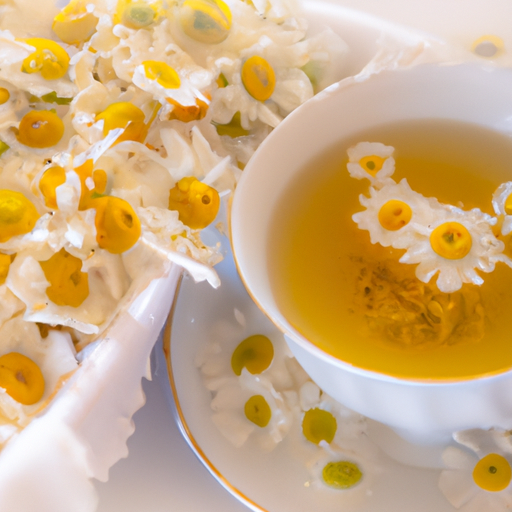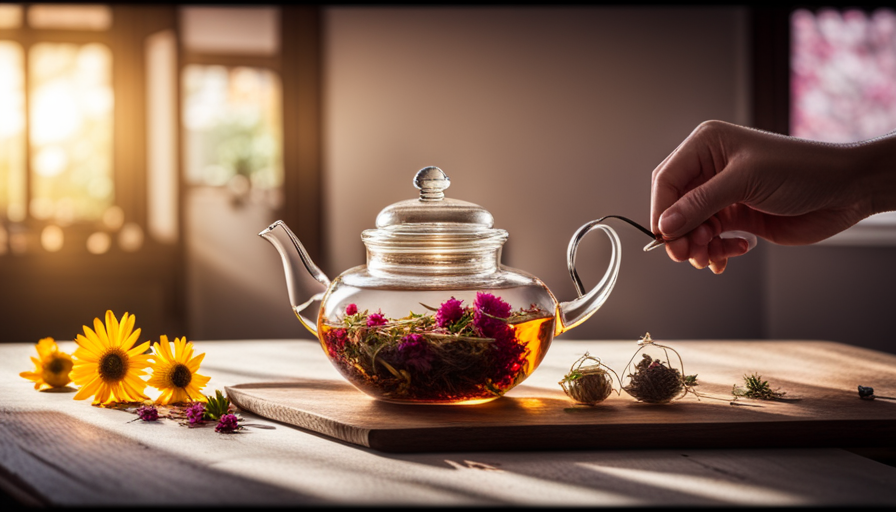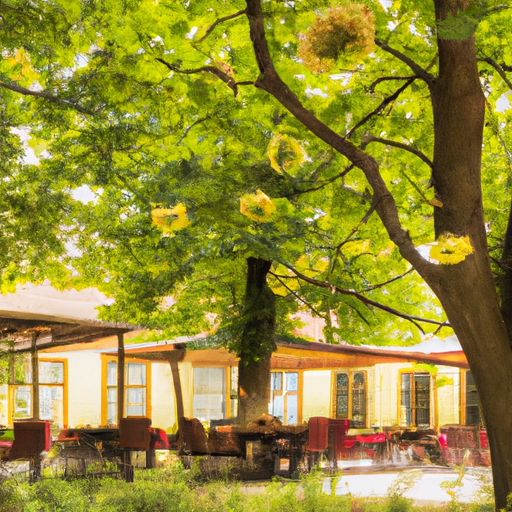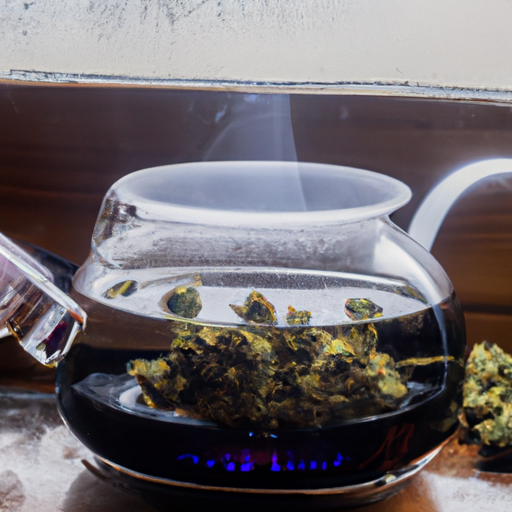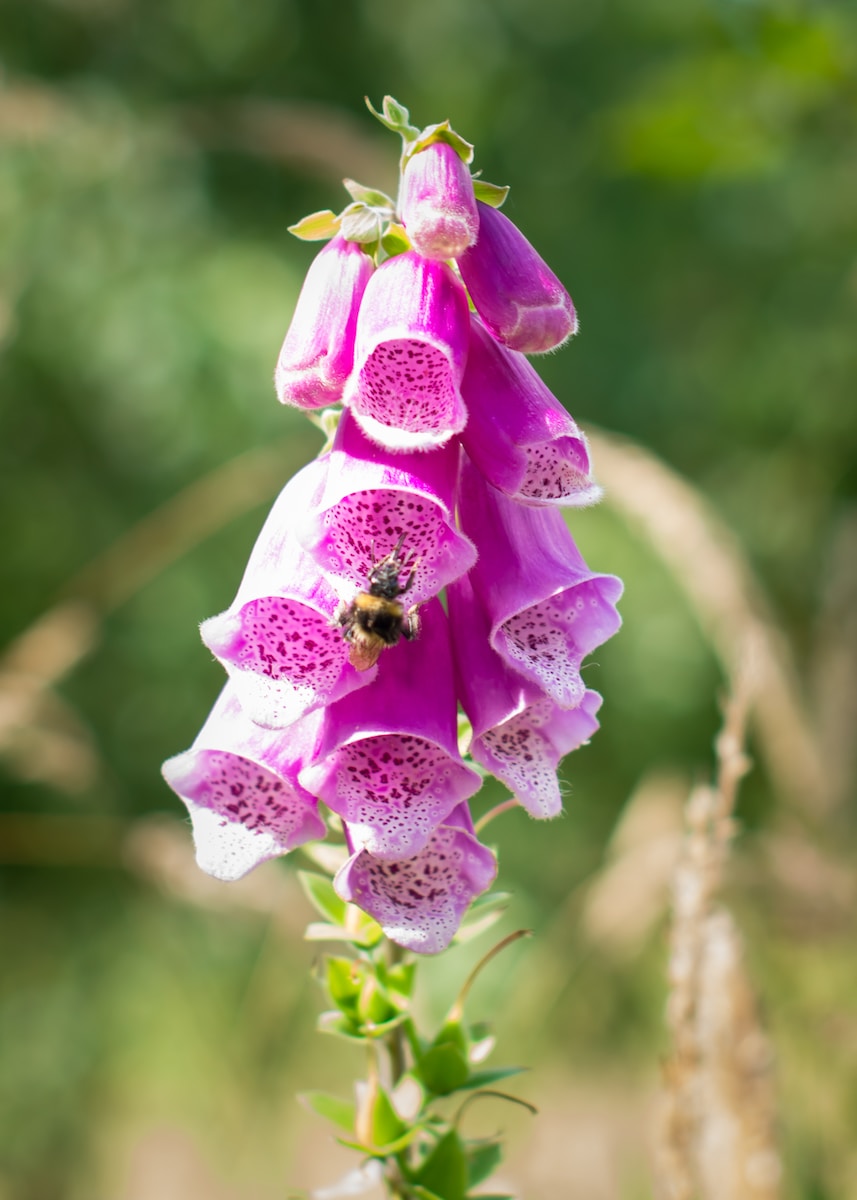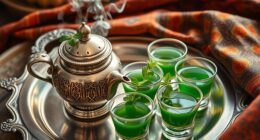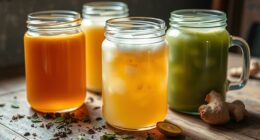Are you prepared to discover the calming effects of chamomile flower tea in a whole new way? Prepare yourself for a detailed guide on crafting this amazing drink.
Chamomile flower tea is not your ordinary cup of tea – it’s a fragrant concoction that will transport you to a state of tranquility and relaxation. With its delicate floral aroma and numerous health benefits, chamomile flower tea is a must-try for tea enthusiasts and wellness seekers alike.
In this article, I will guide you through the process of choosing the right chamomile flowers, gathering the necessary ingredients, and brewing the perfect cup of chamomile flower tea. I will also provide tips on storing and preserving this delightful beverage, as well as discuss possible side effects and precautions.
So, get ready to indulge in the ultimate tea experience and discover the wonders of chamomile flower tea.
Key Takeaways
- Chamomile flower tea promotes relaxation, reduces stress, and improves sleep quality.
- It has anti-inflammatory properties and soothes digestive discomfort.
- Chamomile flower tea is a natural remedy for menstrual cramps and muscle tension.
- German chamomile has a more intense flavor and calming properties, while Roman chamomile has a milder taste and sedative effects.
Benefits of Chamomile Flower Tea
You’ll love the soothing benefits of chamomile flower tea, as it gently lulls you into a state of relaxation, like being embraced by a warm, fragrant hug.
This delightful herbal infusion not only offers a delicious taste, but it also provides numerous health benefits. Chamomile flower tea is renowned for its ability to promote relaxation and reduce stress. The tea contains compounds like apigenin, which have sedative properties that help calm the mind and induce sleep.
Additionally, chamomile flower tea has anti-inflammatory properties that can help soothe digestive discomfort and reduce bloating. It also acts as a natural remedy for menstrual cramps and muscle tension. The relaxation effects of chamomile flower tea can even help alleviate symptoms of anxiety and depression.
To fully experience the benefits of chamomile flower tea, it is important to choose the right flowers. Look for high-quality chamomile flowers that are organic and free from pesticides. Ensure that the flowers are fresh and not faded or wilted. By selecting the best chamomile flowers, you can maximize the therapeutic benefits of your tea.
Choosing the Right Chamomile Flowers
To find the perfect chamomile blooms, start by seeking out a field of sunny daisies, their golden centers inviting you to pluck the delicate petals that will soothe your senses. When choosing chamomile varieties for your tea, it’s important to select the right type of chamomile flowers. The two most common varieties used for tea are German chamomile (Matricaria chamomilla) and Roman chamomile (Chamaemelum nobile). German chamomile has a more intense flavor and is known for its calming properties, while Roman chamomile has a milder taste and is often used for its sedative effects.
When harvesting chamomile flowers, it’s best to do so in the morning when the flowers are fully open. Gently pluck the flower heads, making sure to leave some stems attached for easier drying. Avoid harvesting flowers that are wilted or discolored as they may not provide the same medicinal benefits.
To help you choose the right chamomile flowers, here is a table that compares the two main varieties:
| Chamomile Variety | Flavor | Medicinal Properties |
|---|---|---|
| German Chamomile | Intense, slightly bitter | Calming, anti-inflammatory |
| Roman Chamomile | Mild, slightly sweet | Sedative, digestive aid |
Now that you know how to choose the right chamomile flowers, let’s move on to gathering the rest of the ingredients for your soothing chamomile flower tea.
Gathering the Ingredients
Once you’ve chosen the perfect chamomile blooms, it’s time to gather all the necessary ingredients for creating a soothing and comforting cup of relaxation.
The main ingredient, obviously, is the chamomile flowers. Ensure you have enough flowers to make a strong and flavorful tea.
Additionally, you’ll need water, preferably filtered or spring water for the best taste. The water should be fresh and cold, as this helps to extract the full flavor and benefits of the chamomile flowers.
Next, you’ll need a kettle or a pot for boiling the water. Use a stainless steel or glass kettle to avoid any metallic taste in your tea.
It’s also important to have a strainer or infuser to separate the chamomile flowers from the liquid once the brewing process is complete. This will ensure a smooth and enjoyable cup of tea.
Lastly, you may want to have some optional ingredients on hand to enhance the flavor of your chamomile tea. These can include honey, lemon, or even a splash of milk. Experiment with different additions to find your perfect blend.
Now that you have gathered all the necessary ingredients, let’s move on to the next section where we will explore various brewing methods for chamomile flower tea.
Brewing Methods
Ready to create a soothing cup of relaxation? Let’s explore different brewing methods that’ll have you savoring the benefits of chamomile in no time.
Did you know that steeping chamomile flowers for 5-10 minutes in water at 212°F (100°C) releases the maximum flavor and medicinal properties? It’s essential to choose the right technique to ensure a perfect cup of chamomile flower tea.
One popular brewing technique is the traditional method of steeping. Simply boil water in a kettle and pour it over a teaspoon of dried chamomile flowers in a cup. Let it steep for 5-10 minutes, allowing the flowers to release their aromatic oils and flavors. Strain the tea and enjoy the soothing experience.
Another technique is the teabag method, which offers convenience and simplicity. Place a chamomile teabag in a cup and pour hot water over it. Let it steep for the recommended time, usually 5-10 minutes. The teabag contains pre-measured chamomile flowers, making it easy to achieve the optimal brewing time.
To transition into the subsequent section about step-by-step instructions, let’s delve into the process of preparing chamomile flower tea.
Step-by-Step Instructions
To prepare chamomile flower tea using the infusion method, start by boiling water and pouring it over a teaspoon of dried chamomile flowers in a tea infuser. Let it steep for about 5 minutes, then remove the infuser and enjoy your fragrant and soothing tea.
If you prefer a stronger brew, you can increase the steeping time by a few minutes.
For those who prefer the decoction method, begin by simmering a tablespoon of dried chamomile flowers in a cup of water for about 15 minutes. Strain the liquid and pour it into a teacup, ready to be sipped and savored. This method extracts a deeper flavor and aroma from the chamomile flowers.
If you’re looking for a refreshing and light option, try the cold brew method for chamomile flower tea. Simply place a tablespoon of dried chamomile flowers in a pitcher of cold water and let it steep in the fridge overnight. The next morning, strain the liquid and pour it into a glass with ice. Sip slowly and feel the soothing effects of chamomile.
How to prepare chamomile flower tea using the infusion method
Although it’s a simple process, making chamomile flower tea using the infusion method can provide numerous health benefits, such as improving sleep quality and reducing anxiety. Chamomile flower tea is derived from the dried flowers of different types of chamomile plants, including German chamomile (Matricaria chamomilla) and Roman chamomile (Chamaemelum nobile). These flowers contain essential oils and antioxidants that contribute to their medicinal properties. To prepare chamomile flower tea using the infusion method, follow these steps:
- Boil water in a kettle.
- Place 2-3 teaspoons of dried chamomile flowers in a tea infuser or tea bag.
- Pour the boiling water over the chamomile flowers.
- Let it steep for 5-10 minutes to allow the flowers to release their beneficial compounds.
- Remove the infuser or tea bag and enjoy your soothing chamomile flower tea.
Transitioning into the subsequent section about ‘how to prepare chamomile flower tea using the decoction method’, it is important to note that this alternative method involves simmering the chamomile flowers in water for a longer period to extract their therapeutic properties.
How to prepare chamomile flower tea using the decoction method
Transitioning into the decoction method, you can easily whip up a comforting cup of chamomile flower tea by simmering the dried flowers in water for an extended period, unlocking their therapeutic goodness. Here’s how:
-
Gather your ingredients: dried chamomile flowers and water.
-
In a small saucepan, add 1 tablespoon of dried chamomile flowers for every cup of water.
-
Pour in the desired amount of water and bring it to a gentle boil.
-
Reduce the heat and let the flowers simmer for about 15 to 20 minutes, allowing the water to extract the maximum flavor and health benefits.
-
Strain the tea into a cup, discarding the spent flowers.
-
Savor the soothing aroma and taste of chamomile flower tea, known for its calming effects and potential benefits for sleep and digestion.
Now, let’s move on to explore the refreshing cold brew method for preparing chamomile flower tea.
How to prepare chamomile flower tea using the cold brew method
Get ready for a mind-blowingly easy way to whip up a refreshing and invigorating cup of chamomile flower tea using the cold brew method. The cold brew method involves steeping the chamomile flowers in cold water for an extended period of time, typically overnight. This allows the flavors and beneficial compounds to slowly infuse into the water, resulting in a smooth and delicate tea.
To make chamomile flower tea using the cold brew method, simply place a handful of chamomile flowers in a pitcher of cold water and let it steep in the refrigerator for at least 8 hours. The longer you steep, the stronger the flavor will be. Once steeped, strain out the flowers and serve the tea over ice.
Now, let’s move on to some tips for enhancing the flavor of your chamomile flower tea.
Tips for Enhancing the Flavor
To truly savor the rich and soothing taste of chamomile flower tea, it’s essential to explore creative ways of enhancing its flavor. Here are some flavoring options to elevate your chamomile tea experience:
-
Add a splash of honey: Honey complements the natural sweetness of chamomile and adds a hint of floral complexity to the flavor profile.
-
Try a squeeze of lemon: The tangy citrus notes of lemon can brighten up the mild flavors of chamomile, creating a refreshing and zesty blend.
-
Experiment with different herbs: Combining chamomile with herbs like lavender, mint, or rosemary can introduce new layers of aroma and taste to your tea.
-
Infuse with fruits: Fresh fruits like apples, peaches, or berries can infuse their natural sweetness and fruity essence into your chamomile tea, creating a delightful fusion of flavors.
-
Sprinkle some cinnamon: A pinch of cinnamon can add warmth and a subtle spiciness to your chamomile tea, making it more comforting and inviting.
By exploring these flavoring options, you can customize your chamomile flower tea to suit your personal taste preferences. Now, let’s move on to the next section where we discuss storing and preserving chamomile flower tea.
Storing and Preserving Chamomile Flower Tea
If you want to ensure that your chamomile flower tea stays fresh and flavorful for an eternity, it’s crucial to master the art of proper storage and preservation. The way you store your chamomile flower tea can greatly impact its shelf life and overall quality.
To keep your tea at its best, there are a few storing methods you can employ. Firstly, it’s important to keep your chamomile flower tea in an airtight container to prevent exposure to moisture and air. This will help preserve its delicate flavor and aroma.
Additionally, storing the tea in a cool, dark place, such as a pantry or cupboard, will further protect it from heat and light. It’s also recommended to avoid storing the tea near strong-smelling substances, as chamomile easily absorbs odors.
By following these storage guidelines, you can prolong the shelf life of your chamomile flower tea and ensure it remains fresh and fragrant.
Now, let’s move on to the next section, where we will discuss possible side effects and precautions when consuming chamomile flower tea.
Possible Side Effects and Precautions
When considering the possible side effects and precautions of chamomile flower tea, it’s important to be aware of allergies and sensitivities that may arise.
Additionally, it’s crucial to understand any potential interactions the tea may have with medications currently being taken.
To ensure safe consumption, it’s advisable to follow specific guidelines and dosage recommendations provided by healthcare professionals.
Allergies and sensitivities
Avoiding allergens is crucial when making chamomile flower tea, as some people may have sensitivities or allergies that could cause adverse reactions. Chamomile is generally considered safe for most individuals, but it can still cause allergic reactions in certain cases. Common symptoms of chamomile allergies include skin rashes, itching, and difficulty breathing. If you experience any of these symptoms after consuming chamomile flower tea, it is important to discontinue its use and seek medical attention. To ensure your safety, it is recommended to consult with a healthcare professional before incorporating chamomile tea into your routine, especially if you have a history of allergies or sensitivities.
| Allergies | Sensitivities | Adverse Reactions |
|---|---|---|
| Rash | Irritation | Difficulty |
| Breathing | ||
Understanding these potential allergies and sensitivities can help you enjoy the benefits of chamomile flower tea without any adverse reactions. Moving forward, it is important to explore the potential interactions of chamomile tea with medications, ensuring your well-being and avoiding any unwanted side effects.
Interactions with medications
One must tread carefully when using chamomile flower tea in conjunction with certain medications, as there’s a potential for interactions that could complicate one’s well-being. It’s important to be aware of the potential risks associated with these interactions.
When chamomile is combined with sedatives or anti-anxiety medications, it can enhance their effects, leading to excessive drowsiness or dizziness. Moreover, chamomile tea may interact with blood thinners, such as warfarin, increasing the risk of bleeding.
It’s crucial to consult with a healthcare professional before consuming chamomile tea if you’re taking any medications, especially those mentioned above. By doing so, you can ensure your safety and avoid any potential complications.
Moving forward to the subsequent section about ‘safe consumption guidelines,’ it’s essential to understand the proper ways to enjoy chamomile flower tea without compromising one’s health.
Safe consumption guidelines
Now that we’ve discussed the potential interactions between chamomile flower tea and medications, it’s important to understand the safe consumption guidelines for this herbal remedy.
While chamomile tea is generally considered safe for most people, it’s essential to follow certain precautions. First and foremost, it’s recommended to consult with a healthcare professional before incorporating chamomile tea into your routine, especially if you have any underlying health conditions or you’re taking any medications.
Additionally, it’s important to be aware of possible side effects such as allergic reactions and adverse interactions with other herbal supplements or medications. To ensure safe consumption, it’s generally advised to start with a low dosage and gradually increase it if necessary. It’s also recommended to limit the consumption of chamomile tea to a moderate amount and to avoid drinking it for extended periods of time.
With these precautions in mind, let’s now explore other uses for chamomile flowers.
Other Uses for Chamomile Flowers
Discover the numerous ways chamomile flowers can enhance your life, from soothing skincare remedies to calming aromatherapy treatments. Chamomile flowers have been used for centuries in various cultures for their medicinal properties and pleasant aroma.
Apart from making a delightful cup of chamomile flower tea, there are several other uses for these versatile flowers. One popular use for chamomile flowers is in skincare remedies. Chamomile-infused oils or creams can help soothe skin irritations such as rashes, burns, and eczema. The anti-inflammatory properties of chamomile can reduce redness and swelling, promoting healing and providing relief.
Chamomile flowers can also be incorporated into various recipes. You can infuse your favorite oils or honey with chamomile flowers to add a delicate floral flavor to your dishes. From chamomile-infused salad dressings to chamomile-flavored ice cream, the possibilities are endless.
In addition, chamomile flowers are commonly used in aromatherapy. The gentle scent of chamomile promotes relaxation and can help alleviate stress and anxiety. You can create your own chamomile flower sachets or add chamomile essential oil to your diffuser for a calming and peaceful ambiance.
Chamomile flowers offer more than just a soothing cup of tea. Their uses extend to skincare remedies, culinary delights, and calming aromatherapy treatments. Incorporating chamomile flowers into your daily routine can enhance your overall well-being and add a touch of tranquility to your life.
Conclusion and Final Thoughts
Closing thoughts and reflections on the versatility and benefits of incorporating chamomile flowers into various aspects of your life can leave you feeling calm, content, and captivated by their captivating charm.
Chamomile flowers, with their myriad uses, aren’t just limited to making a soothing tea. They can be utilized in numerous ways to enhance your well-being and surroundings.
Chamomile flowers have proven to be a valuable addition to our daily lives. They offer a range of benefits, from promoting relaxation and aiding in sleep to soothing skin irritations and reducing inflammation.
Incorporating chamomile flowers into your skincare routine can leave your skin feeling rejuvenated and refreshed. Adding chamomile flowers to your bath can create a blissful and calming experience.
To recap, chamomile flowers possess a wealth of therapeutic properties that can enhance both your physical and mental well-being. Their gentle and soothing aroma can alleviate stress and anxiety, while their anti-inflammatory properties can provide relief from various ailments.
Whether enjoyed as a tea, used in skincare products, or incorporated into a relaxing bath, chamomile flowers are a versatile and beneficial addition to any lifestyle.
- Chamomile flowers offer a natural and effective way to promote relaxation and reduce stress.
- Incorporating chamomile tea into your bedtime routine can improve sleep quality.
- Chamomile flowers can be used in aromatherapy to create a calm and serene atmosphere.
- Chamomile flowers have potent anti-inflammatory properties that can help alleviate skin irritations.
- Adding chamomile flowers to homemade skincare products can nourish and soothe the skin.
- Applying chamomile-infused oil can provide relief from eczema and other skin conditions.
- Chamomile flowers can be used in a therapeutic bath to relax and unwind.
- Adding dried chamomile flowers to your bathwater can create a soothing and aromatic experience.
- The calming properties of chamomile flowers can help relieve muscle tension and promote relaxation.
Incorporating chamomile flowers into your lifestyle can have a profound impact on your overall well-being. From the calming effects of chamomile tea to the soothing properties of chamomile-infused skincare products, these versatile flowers offer a multitude of benefits. So, why not embrace the captivating charm of chamomile flowers and discover the tranquility and serenity they can bring to your life?
Frequently Asked Questions
Can chamomile flower tea help with anxiety and sleep disorders?
Chamomile flower tea has various benefits, including its potential to alleviate anxiety and sleep disorders. It’s a natural remedy that has been used for centuries due to its calming properties. The dosage of chamomile flower tea varies, but generally, it’s recommended to steep 2-3 teaspoons of dried chamomile flowers in hot water for about 5 minutes. However, it’s important to consult a healthcare professional for personalized advice on chamomile flower tea dosage.
What is the difference between German chamomile and Roman chamomile?
German chamomile and Roman chamomile are two different species of chamomile flowers. They share similarities in their calming properties, making them beneficial for relaxation and stress relief. However, there are also notable differences between the two.
German chamomile has a stronger, more bitter taste, while Roman chamomile is sweeter and milder. German chamomile is often used for medicinal purposes, while Roman chamomile is commonly used in aromatherapy.
Both varieties can be brewed into soothing chamomile flower tea.
Can I use dried chamomile flowers instead of fresh ones?
Yes, you can use dried chamomile flowers instead of fresh ones for making tea. Using dried chamomile flowers for tea offers various benefits. Dried flowers have a longer shelf life and are easier to store. They retain their aroma and flavor, ensuring a delightful cup of tea. Additionally, the drying process intensifies the concentration of certain beneficial compounds in chamomile, such as chamazulene and flavonoids, which can provide soothing effects and promote relaxation.
How long does it take to brew chamomile flower tea?
The brewing time for chamomile flower tea is approximately 5-10 minutes. This quick steeping process allows the tea to release its soothing properties and delicate flavor.
It’s important to note that the best brewing temperature for chamomile flower tea is around 200°F (93°C). This temperature ensures optimal extraction of the tea’s beneficial compounds.
So, in just a matter of minutes, you can enjoy a warm cup of chamomile flower tea at its finest.
Are there any known drug interactions with chamomile flower tea?
There are potential drug interactions to consider when consuming chamomile flower tea. It’s important to note that chamomile contains compounds that may interact with certain medications, such as blood thinners, sedatives, and anti-anxiety drugs. It’s advisable to consult with a healthcare professional before incorporating chamomile tea into your routine, especially if you’re taking any medications.
Despite these interactions, chamomile tea offers numerous benefits, including promoting relaxation, aiding digestion, and reducing inflammation.
Conclusion
In conclusion, making chamomile flower tea is a simple yet fulfilling process. By carefully selecting the right flowers and following the step-by-step instructions, you can create a soothing and comforting drink that offers numerous health benefits.
However, it’s important to be aware of possible side effects and precautions before consuming this tea. Additionally, chamomile flowers can be used for various purposes beyond tea-making. So, why not embark on this journey of relaxation and indulge in the beauty and tranquility of chamomile flower tea?


